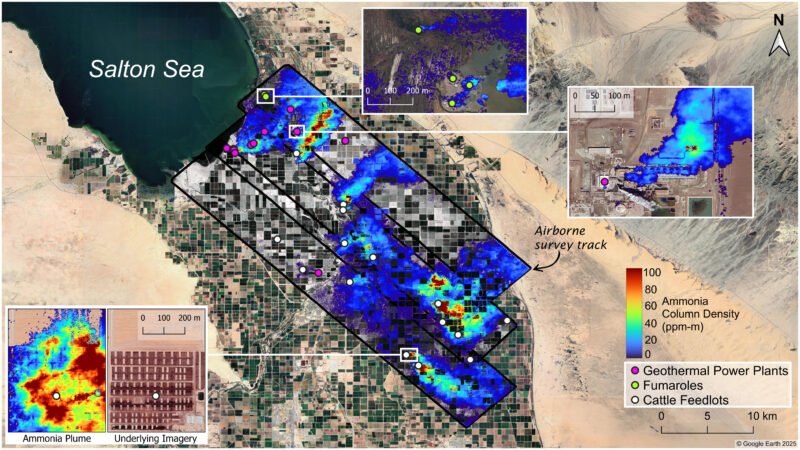Quick Takeaways
-
Detection of Ammonia: Using advanced instruments, researchers identified elevated ammonia levels near agricultural fields, livestock feedlots, and geothermal sites, with Imperial Valley showing concentrations 2½ to eight times higher than Coachella Valley’s Mecca community.
-
Health Risks: Although ammonia is not toxic in low doses, it contributes to PM2.5 particulate pollution, which is linked to serious health conditions like asthma and cardiovascular disease, making its monitoring crucial.
-
Improved Monitoring Techniques: The study employed airborne instruments for high-resolution data collection, revealing distinct ammonia plumes and providing valuable insights into emissions from specific sources, including geothermal power plants and cattle farms.
-
Policy Implications: Findings underscore the need for expanded ammonia monitoring and will help air quality regulators prioritize emission sources effectively, aiding efforts to improve local air quality in Coachella Valley.
NASA, Aerospace Corporation Study Sharpens Focus on Ammonia Emissions
A recent study by NASA and the Aerospace Corporation highlights rising ammonia emissions and their impacts on air quality. Researchers used advanced instruments to detect ammonia’s chemical signature via infrared light. They found elevated levels near agricultural fields, livestock feedlots, and geothermal sources. In the Imperial Valley, measurements were 2½ to eight times higher than those in nearby Mecca, where ammonia levels matched background concentrations.
Though ammonia itself isn’t toxic in low amounts, it can form particulate matter, known as PM2.5. This type of pollution poses health risks, including asthma and cardiovascular disease. “More attention has focused on direct sources of PM2.5, like vehicle emissions,” said a lead researcher. As air quality regulations become stricter, understanding ammonia as a precursor to PM2.5 becomes crucial.
Previous satellite studies indicated a global increase in atmospheric ammonia. However, these studies only provided broad trends, lacking the spatial resolution needed for localized insight. Ammonia poses unique challenges for monitoring because it reacts quickly in the atmosphere.
To address this, researchers conducted flights over the Imperial and Coachella valleys in March and September 2023. They gathered data from both airplanes and ground stations, enhancing the accuracy of their findings. The team produced maps that identified ammonia sources and tracked plumes coalescing into larger clouds.
During the flights, the team observed distinct ammonia emissions from geothermal plants, cattle farms, and natural vents. For example, one plume from a cattle facility stretched up to 1.7 miles wide, significantly impacting local air quality.
The study also recorded seasonal changes at a fixed monitoring station in Mecca. Researchers noted that winds can carry ammonia from the Imperial Valley to surrounding areas. This detailed spatial information has already influenced local regulatory decisions, leading to expanded ammonia monitoring efforts.
Ammonia, while just one part of a larger pollution puzzle, plays a key role in understanding local air quality. Knowledge from this research helps pinpoint pollution sources and prioritize which areas require attention, ultimately guiding improvements in community health and environmental standards.
Discover More Technology Insights
Explore the future of technology with our detailed insights on Artificial Intelligence.
Stay inspired by the vast knowledge available on Wikipedia.
SciV1

